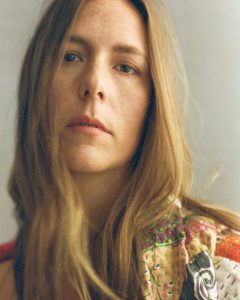When her album Landing was launched three years ago, there was a lot said about the meandering journey that led Amélie Beyries to songwriting. A long creative process, strewn with personal pitfalls, had pushed the thirty-something to declare herself an artist late in life, although she was still a little embarrassed to assume this role completely.
 The success of Landing, and the numerous accolades that followed, informed the project that would become BEYRIES. After a smooth landing, the artist wanted to meet the audience that had embraced her intimate songs.
The success of Landing, and the numerous accolades that followed, informed the project that would become BEYRIES. After a smooth landing, the artist wanted to meet the audience that had embraced her intimate songs.
“I sometimes wish I would write lighter songs that I could sing with a degree of detachment, but I just can’t,” says the singer. “I’m the type who’ll break down crying on stage, and it happens a lot! It made me anxious, initially, but I quickly understood that audiences are generally benevolent towards artists, they don’t want you to fall flat on your face, they’re there to support you. I’m not an entertainer, and I don’t think I’ll ever be, but I’ve come to love this trade, thanks to the exchanges I have with the audience during my concerts.”
Encounters are indeed the central theme of her sophomore album, Encounter, where she offers the same timeless sound, which she’s nonetheless expanded and tweaked alongside her longtime producer, multi-instrumentalist Alex McMahon. “We found out we still had a lot to say, and we wanted to see where our musical relationship could go,” Beyries explains. “Alex asked me what I wanted to do, and all I said was that I wanted… wider songs, something more unifying.”
The folk roots remain the same, but BEYRIES ventures into pop territory on catchy songs like “Over Me,” which is almost reminiscent of Florence and the Machine, or the languid Keep it to Yourself, in which the bass line engages in a dialogue with the strings. Those string arrangements, penned by Antoine Gratton, are an integral part of the desired sonic expansion, and one of the rare elements that’s not the fruit of the creative BEYRIES-McMahon powerhouse.
“Alex is so talented, he can play any instrument! During the recording sessions, he played the guitar and bass parts, and they’re not at all his favourite instruments, yet when we asked ‘real’ guitarists to play those parts, everybody agreed that Alex’s versions were way better. He plays with instinct and passion, which a very rare talent.”
Although she says she listens to a wide variety of musical genres, Beyries remains true to the core artists that made her who she is: Cat Stevens, The Beatles, and Elton John. Through those influences, she seeks to bring a timeless touch to her own compositions.
“Landing was voluntarily a sparse album,” she says. “I wanted the focus to be on the vocal harmonies. This time around, I felt like hearing something bigger, wider, although all of those songs can easily be boiled down to their simplest expression; I can sing all of them guitar-voice, piano-voice, or even a capella.”
That comes as no surprise, since all of them were written on the family piano, a 1923 Heintzman that Beyries had meticulously restored. “It’s the only object I’m attached to,” she says. “I’m self-taught on the piano, but playing on that particular instrument, that my mom and grandma used to play, is a connection with my past. It’s something highly emotional for me.”
Although Beyries is a specialist in the intimate sphere, she still looks outwards, notably on the incisive “Graceless,” which might almost be classified as a protest song. “I usually try to leave my songs open-ended, so that people can read what they want into them, but with this one I really wanted to express my distress about the direction the human race is going in,” she says. “Call it my pre-apocalyptic song… I wonder just how far we’re going to go in the de-humanization and destruction of our planet. Are we going to succeed in coming together to face the major issues that threaten our survival?”
Short of offering an answer, BEYRIES songs are there to accompany us, and remind us of our common humanity. It’s a good start…